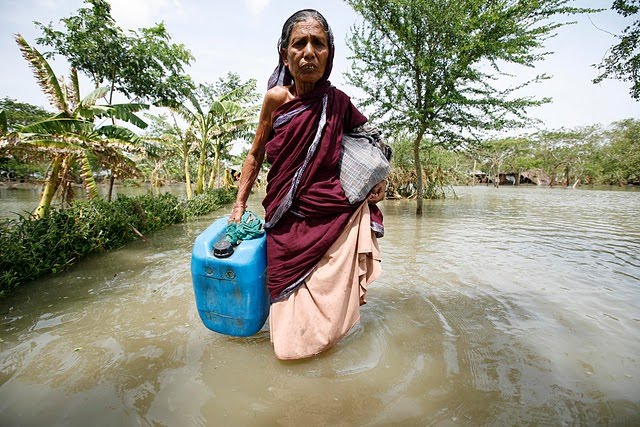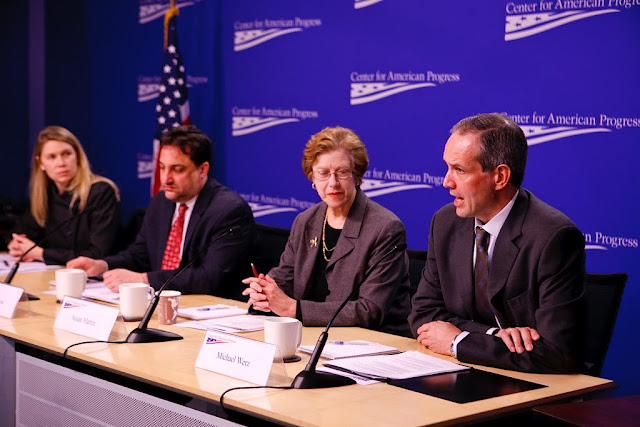-
Maternal and Newborn Health as a Priority for Strengthening Health Systems
›Among the many initiatives that have recently been launched to strengthen health systems in the developing world, there is little consensus on execution. Traditional strategies for improving the health system, such as the vertical approach, which prioritizes communicable diseases, or the horizontal approach, which prioritizes non-communicable diseases, are limited in scope and fail to include a comprehensive gender lens.
To overcome the shortcomings of these two health financing approaches, the “diagonal” strategy combines them by “clearly defining priorities and utilizing these priorities to drive general improvements of the health system,” said Julio Frenk, dean of the Harvard University School of Public Health, at the Global Health Initiative’s third event in the “Advancing Policy Dialogue on Maternal Health” series.
Along with panelists Helen de Pinho of Columbia University, and Agnes Soucat of the World Bank, Frenk discussed how prioritizing key maternal health indicators can improve health systems and support the implementation of evidence-based interventions. Putting Women and Health First
Putting Women and Health First
Drawing on his experience as Mexico’s minister of health, Frenk said that clearly defining a set of priorities grounded in “women and health” drove the improvement of Mexico’s health system. “Picture three concentric circles. The core of these concentric circles is the prevention of maternal mortality and disability; the second circle [includes] other aspects of sexual and reproductive health in addition to pregnancy and delivery; the third circle includes other fundamental areas of women’s health and the intersection of women with the health system,” said Frenk.
Mexico used maternal mortality rates to measure quality of care and rectify weaknesses in the health system. “Every maternal death triggered an audit that could lead to a hospital losing its license to operate,” said Frenk. Additionally, these audits helped to identify gaps and prioritize investments in “equipment and supply of drugs…and networks [for] obstetric emergencies,” he added.
“This illustrates how you can take a specific set of priorities and drive them through,” argued Frenk. “Global health needs to get out of the traditional confines that have split the community between vertical and horizontal and adopt more integrated frameworks like the notion of women and health,” he said, which “will leave behind a better health system to deal with the next challenge.”
Measuring Maternal Health
The maternal health community agrees that to reduce maternal mortality rates, access to emergency obstetric care (EmOC) must be improved. “A simple assessment of an emergency obstetric care facility combines a number of aspects that are core to strong health systems,” said de Pinho. To reduce maternal mortality, a strong health system must be able to positively answer these key questions:
These questions monitor the availability, utilization, and quality of care, which signals whether “the health system is actually responding to the woman’s needs when they need it,” said de Pinho. These maternal health indicators “paint a picture for where next steps need to be taken,” she said.- Are there enough facilities providing EmOC and are they well distributed?
- Are women with obstetric complications using these facilities?
- Is the quality of the EmOC services adequate?
Rwanda’s Innovations in Health Financing
“When we talk to ministries of health we ask them what are the low-hanging fruits we can reach in the six years” until the deadline for meeting the Millennium Development Goals (MDGs), said Soucat. To implement methods with proven results, additional research data, monetary support, and political will are all necessary. Rwanda’s ministry of health used the health-related MDGs—particularly MDG 5 to reduce maternal deaths by 75 percent—to reform the health system and hold institutional and individual actors accountable.
Rwanda’s health system was reformed through five key pillars:
“The heart of the reform is to increase accountability to its citizens,” said Soucat. Rwanda’s results-based financing offered “incentives and salary supplements to workers who saw more patients and provided higher quality of care,” she said. Impact assessments demonstrate that all income groups in Rwanda benefited from this health care scheme; in three years family planning tripled and assisted deliveries increased by 13 percent –“something that has never been observed in Africa,” she said.- Fiscal decentralization increased community participation and allocated funds to district governments
- Performance contracts were established between the president and district mayors
- A performance-based financing system distributed money to health facilities based on results
- Community health insurance increased access and reduced out-of-pocket expenditures
- Autonomous health facilities were allowed to hire and fire personnel
Rwanda’s Ministry of Health conducted rigorous assessments to ensure quality services and demonstrate impact to the Ministry of Finance. “When talking about maternal health a strong dialogue between the Ministry of Health and Ministry of Finance is needed more than ever and centered around the production of results,” argued Soucat. Scaling up the results-based finance scheme in other African countries is possible, she said, but additional research is needed to better understand this scheme at the decentralized level. -
Family Planning and Reproductive Health
›Adding it Up: The Costs and Benefits of Investing in Family Planning and Maternal and Newborn Health, a report by the Guttmacher Institute, asserts that “sustained and increased investment in sexual and reproductive health services in developing countries” would “contribute to economic growth, societal and gender equity, and democratic governance.” The report presents cost-benefit analyses of family planning and maternal and newborn health strategies in an effort to “guide decision makers, at the global, regional and country levels, in making investments that would reap the greatest returns for individuals and societies.” The Interagency Gender Working Group recently released Gender Perspectives Improve Reproductive Health Outcomes: New Evidence, argues for the importance of taking gender into consideration when developing interventions related to unintended pregnancies, maternal health, STIs, harmful practices (e.g. early marriage, genital cutting, and gender-based violence), and youth. The report, a follow-up to 2004’s The “So What?” Report: A Look at Whether Integrating a Gender Focus into Programs Makes a Difference to Outcomes, includes 40 specific examples of programs successfully integrating gender to improve reproductive health.
The Interagency Gender Working Group recently released Gender Perspectives Improve Reproductive Health Outcomes: New Evidence, argues for the importance of taking gender into consideration when developing interventions related to unintended pregnancies, maternal health, STIs, harmful practices (e.g. early marriage, genital cutting, and gender-based violence), and youth. The report, a follow-up to 2004’s The “So What?” Report: A Look at Whether Integrating a Gender Focus into Programs Makes a Difference to Outcomes, includes 40 specific examples of programs successfully integrating gender to improve reproductive health. -
Climate Change: A Threat to Global Security
›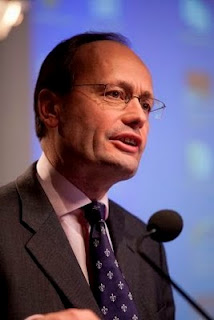 Having recently returned from Washington, where I shared a platform at the Woodrow Wilson Center with Deputy Assistant Secretary of Defense Amanda Dory, I am struck by how similar UK and U.S. thinking is on the national security implications of climate change. Our defense departments agree that the impact of climate change is likely to be most severe in areas where it coincides with other stresses, such as poverty, demographic growth, and resource shortages: areas through which much of the world’s trade already passes. We are also in agreement that climate change will accelerate global instability and that it is likely to shape our future missions and tasks. In particular we can expect to receive more frequent requests for assistance after extreme weather events.
Having recently returned from Washington, where I shared a platform at the Woodrow Wilson Center with Deputy Assistant Secretary of Defense Amanda Dory, I am struck by how similar UK and U.S. thinking is on the national security implications of climate change. Our defense departments agree that the impact of climate change is likely to be most severe in areas where it coincides with other stresses, such as poverty, demographic growth, and resource shortages: areas through which much of the world’s trade already passes. We are also in agreement that climate change will accelerate global instability and that it is likely to shape our future missions and tasks. In particular we can expect to receive more frequent requests for assistance after extreme weather events.
So if we recognize the threats, what can we do about them? In the United Kingdom we believe that the approach is two-fold. First, we need to address the problem that we have already caused, the damage that we have done to the climate out to about 2030, through adaptation and planning for potential scenarios. But to limit the threat to our security, we must also address the underlying causes.
Key to achieving this is limiting temperature rises to 3.6 degrees Fahrenheit, when compared with pre-industrial times, since beyond that, the risks will increase greatly. This will be no easy task and will require us to start cutting our emissions now, taking action by being more efficient and investing in low-carbon technology. The United Kingdom has the world’s first legally binding emissions reduction targets, and is investing in a variety of technologies, including wind, nuclear, and carbon capture and storage. These measures will not only contribute to our long-term security by reducing damaging carbon emissions, but they will also insulate us against fossil fuel price fluctuations and thereby increase our energy security.
It is the job of any responsible military to plan not just for the national security challenges that face us currently, but for those that might appear on our horizon in the future. Sometimes new challenges appear from newly destabilized areas of the world. Sometimes they arise from new methods of warfare, or new trends in science and technology. Often, they stem from changes in the conditions under which our militaries operate. Just as we are alive to geopolitical trends in every continent, and technical advances made by both our allies and those who seek to harm our interests, our militaries must proactively anticipate the environmental changes that will impact our national security in the coming years. Current military operations will, rightly, always be our highest priority, but we must also find time to address future threats, including climate change.
Indeed, in some countries climate change is already impacting on the work of the military. When I talk to colleagues from Africa and Southeast Asia it is apparent that they are already taking into account the consequences of climate change when determining their priorities.
The United States and United Kingdom can work together to establish a greater understanding of the security implications of climate change and how they will affect our missions and tasks. We cannot afford to be caught unprepared when climate-related conflicts challenge our ability to deliver our core mission of providing national security – a risk that we must avoid.
Rear Admiral Neil Morisetti is an active duty officer in the British Royal Navy and is the United Kingdom’s Climate Security Envoy -
A Forecast of Push and Pull: Climate Change and Global Migration
›March 10, 2010 // By Julien Katchinoff
“As we …talk about the interconnections between climate change and migration we need to look at the interconnections in a way that understands what’s positive about the processes of migration and what’s problematic,” said Susan Martin, Herzberg Professor of International Migration at Georgetown University, during a recent event on climate and migration at the Center for American Progress.
Susan Martin joined Cynthia Brady, senior conflict advisor for the Office of Conflict Management and Mitigation at USAID and David Waskow, director of the Climate Change Program at Oxfam America, to identify the catalysts for future population flows, offer pragmatic policy solutions, and discuss work to be done on the ground.
While reminding the audience that climate-induced migration will tend to follow already existing patterns, Susan Martin broadly outlined four major intersections between migration and climate change impacts:
“Slow” Migration Pressures:- Drought or desertification resulting in a loss or depreciation of livelihoods.
Result: Push working family members to migrate to domestic or international urban centers. - Rising sea levels damaging fishing and agriculture opportunities.
Result: Migration to inland regions to reduce future risk.
“Rapid” Migration Pressures:- Intensification of natural disasters and damage to infrastructure.
Result: The coping costs increase to the point where they push large numbers of people to leave their homes. Most individuals migrate internally. Of the four intersections, this is currently the most common. - Threats to the availability of food, water, and other natural resources.
Result: Low or high intensity conflict, leading to migrations. The short timeframes and potentially large numbers of migrants involved make this driver the most problematic. Differing degrees of internal political stability are factors that can interfere for better or worse.
Yet these relationships are not without controversy. “Environmentalists have tended to see the issue of migration as a way of getting attention to mitigation and have often talked about migration in very alarmist terms,” Martin said. “Migration experts, on the other hand, have been very skeptical about the interconnection.” Instead, they have argued that other push and pull factors outside of climate are much more significant to the migration calculation.

Operating from the perspective that migration itself is an adaptation failure, David Waskow outlined several strategies that Oxfam deploys to help communities copewith uncertain futures:
- Building climate resilience and developing adaptation strategies: Proactive approaches are essential, as agencies and communities can address future threats with disaster planning and creating early-warning systems.
- Managing risk: The establishment of micro-insurance projects can cushion vulnerable populations against unexpected economic shocks.
- Resettling communities: The movement of rural populations to urban areas could result in tensions over land use and strains on urban governance and carrying capacities. As a result, this approach is left as a last recourse.
Brady, though in agreement with Waskow concerning climate change’s threat to livelihoods and its role as a catalyst for conflict, suggested that there may be positive opportunities for managing climate risks. “The environment can and does provide an essential and effective platform for dialogue, communication, and confidence-building around shared interests,” Brady said. “It may be that certain conflicts actually lend themselves to the use of climate-related collaboration as a mechanism to resolve conflict or reduce tension between parties,” she said.
Climate-related projects at the community-level, from adaptive early-warning systems to mitigating carbon storage schemes, hold the possibility to bring groups together in cooperative projects, build confidence, and defuse existing tensions. Transparent and participatory management of new investments may also increase trust in local and national governments with whom trust was previously lacking. While forestalling crises in the future, adaptation projects also hold the potential to unlock opportunities for peacebuilding and conflict resolution today.
Photo Credits: Photo 1 courtesy Oxfam America. Photo 2 courtesy Center for American Progress. - Drought or desertification resulting in a loss or depreciation of livelihoods.
-
World Bank Data Visualization
›Yesterday Google and the World Bank expanded their data-sharing partnership, first initiated last fall, to include a subset of 54 World Development Indicators and enhanced visualization tools. Users can now interact with data—spanning a range of both environmental and population statistics, from forest coverage area to contraceptive prevalence—using line graphs, bar graphs, maps, and xy-plots. Each option also offers users the ability to follow the data changes over time.
An alternative to Google’s Public Data Explorer is the World Bank’s Data Visualizer. Although limiting data output to an xy-plot, the customization options go beyond those offered by the Public Data Explorer and achieve a good balance between flexibility and ease of use. Table colors and groupings are fully customizable, scales are adjustable, and the chart can be quickly printed or exported as a jpeg. -
Urbanization and Deforestation
›The journal Nature Geoscience recently published a study comparing the impacts of rural and urban population growth on deforestation. “Deforestation Driven by Urban Population Growth and Agricultural Trade in the Twenty-First Century” finds deforestation is positively correlated with urban population growth and agricultural exports to international markets. In rural areas, however, the link between deforestation and population growth was absent, indicating that urbanization and agricultural export-oriented economies were the primary drivers for forest loss. The study concludes that, rather than focusing on the activities of rural populations, deforestation reduction efforts should target “industrial-scale, export-oriented agricultural production, concomitant with efforts to increase yields in non-forested lands.” (SUBSCRIPTION ONLY)
“The Population, Agriculture, and Environment Nexus in Latin America: Country-Level Evidence from the Latter Half of the Twentieth Century,” a study published in the journal Population & Environment, examines the relationship between land use and population shifts in Latin America between 1961 and 2001. The paper focuses on deforestation, which was found to be spurred by both Malthusian and Boserupian demographic drivers. It concludes that population growth, urban consumption patterns, and land-use constraints will continue to pose challenges for Latin American policymakers trying to achieve a sustainable equilibrium. (SUBSCRIPTION ONLY) -
Visualizing Natural Resources, Population, and Conflict
›Environmental problems that amplify regional security issues are often multifaceted, especially across national boundaries. Obtaining a comprehensive understanding of the natural resource, energy, and security issues facing a region is not fast or easy.
Fortunately, the Environment and Security Initiative (ENVSEC) has created highly informative, easy-to-understand maps depicting environmental, health, population, and security issues in critical regions.
Published with assistance from the United Nations GRID-Arendal, these maps offer policymakers and the public a snapshot of the complex topography of environmental security hotspots in Central Asia, Eastern Europe, Southeastern Europe, and the Southern Caucasus.
Some that caught our eye:
• Environmental Issues in the Northern Caspian Sea: Overlaying environmental areas and energy production zones, this map finds hydrocarbon pollution in sturgeon spawning grounds, seal habitats in oil and gas fields, and energy production centers and waste disposal sites in flood zones.
• Water Withdrawal and Availability in the Aral Sea Basin: Simple and direct, this combination map and graph contrasts water usage with availability in Turkmenistan, Uzbekistan, and Kazakhstan—which stand in stark comparison to the excess water resources of Tajikistan and Kyrgyzstan.
• Environment and Security Issues in Belarus: In addition to noting the parts of the country with poor water quality and potassium mining, the map also delineates wildfires that occurred in areas contaminated by the Chernobyl explosion, thus threatening downwind populations.
Maps: Illustrations courtesy of the Environment & Security Initiative. -
VIDEO – Juan Dumas on Natural Resources, Conflict, and Peace
›February 24, 2010 // By Michelle NeukirchenMediation and conflict resolution around natural resources require “long-term engagement, timely interventions, and lots of flexibility,” says Juan Dumas, senior advisor for the Fundación Futuro Latinoamericano in Quito, Ecuador. The Woodrow Wilson Center and the Fetzer Institute hosted Dumas for a roundtable event on Pathways to Peace: Stories of Environment, Health, and Conflict. In this interview with ESCP Director Geoff Dabelko, Dumas shares key lessons learned from his experience with his NGO that specializes in prevention and management of socio-economic conflicts around natural resources.
In order to overcome challenges posed by current funding procedures, the foundation has been trying to establish an “early-action fund” that would provide flexible funding to facilitate conflict resolution dialogue. “With the right capacities at the right time… you can make a difference… you can prevent the escalation of conflict into violence… and create a governance path for that conflict to be addressed in a different way,” Dumas says.
Showing posts from category *Main.


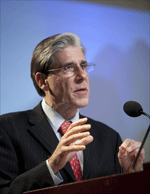 Putting Women and Health First
Putting Women and Health First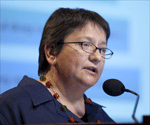
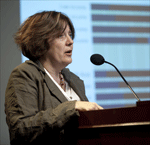

 The
The 